inflation pressure TOYOTA YARIS 2020 Warranties & Maintenance Guides (in English)
[x] Cancel search | Manufacturer: TOYOTA, Model Year: 2020, Model line: YARIS, Model: TOYOTA YARIS 2020Pages: 260, PDF Size: 8.54 MB
Page 35 of 260
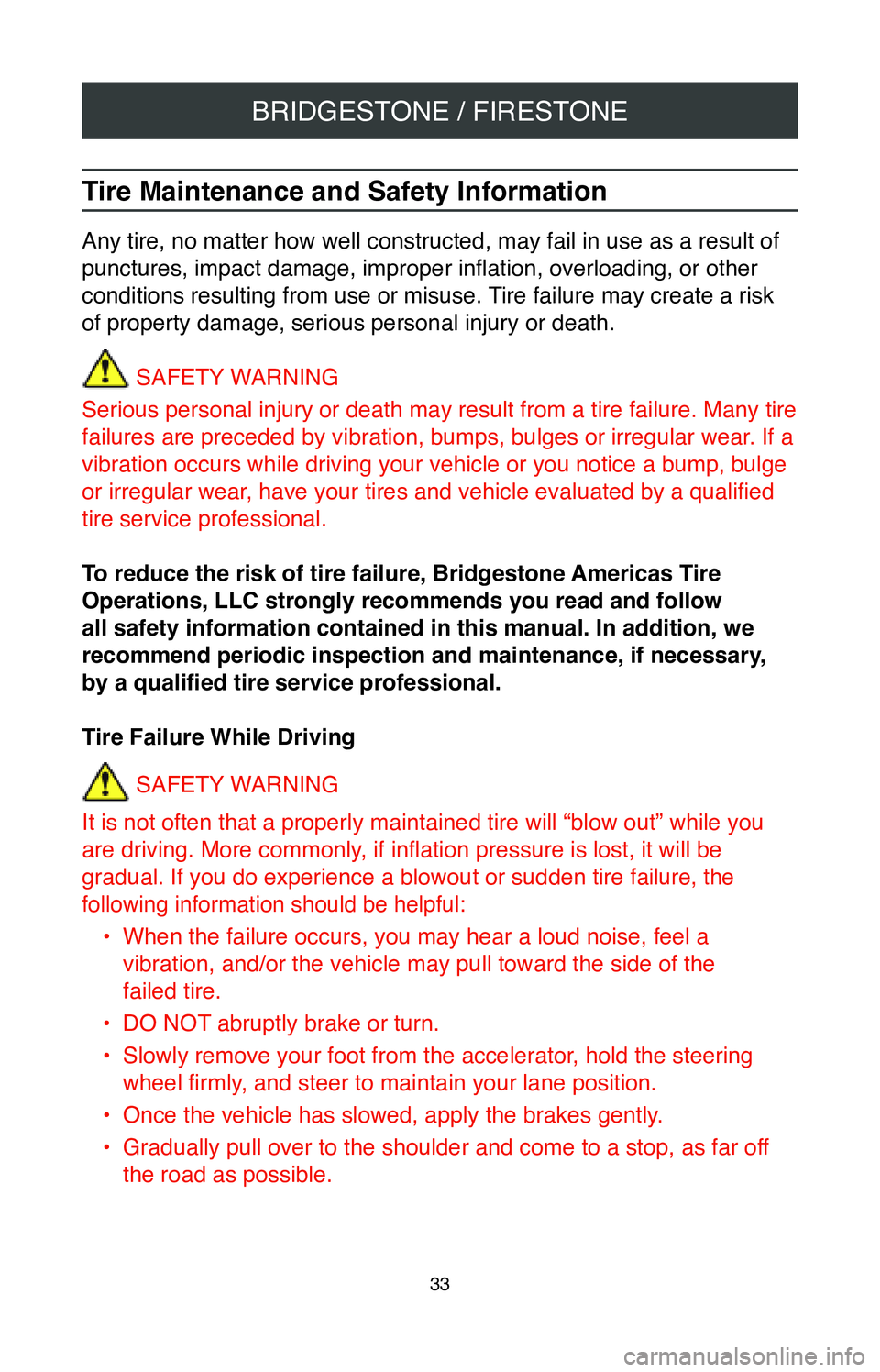
BRIDGESTONE / FIRESTONE
33
Tire Maintenance and Safety Information
Any tire, no matter how well constructed, may fail in use as a result of\
punctures, impact damage, improper inflation, overloading, or other
conditions resulting from use or misuse. Tire failure may create a risk
of property damage, serious personal injury or death.SAFETY WARNING
Serious personal injury or death may result from a tire failure. Many tire
failures are preceded by vibration, bumps, bulges or irregular wear. If a
vibration occurs while driving your vehicle or you notice a bump, bulge \
or irregular wear, have your tires and vehicle evaluated by a qualified
tire service professional.
To reduce the risk of tire failure, Bridgestone Americas Tire
Operations, LLC strongly recommends you read and follow
all safety information contained in this manual. In addition, we
recommend periodic inspection and maintenance, if necessary,
by a qualified tire service professional.
Tire Failure While Driving
SAFETY WARNING
It is not often that a properly maintained tire will “blow out” wh\
ile you
are driving. More commonly, if inflation pressure is lost, it will be
gradual. If you do experience a blowout or sudden tire
failure, the
following information should be helpful:
• When the failure occurs, you may hear a loud noise, feel a
vibration, and/or the vehicle may pull toward the side of the
failed tire.
•
DO NOT abruptly brake or turn.
•
Slowly remove your foot from the accelerator, hold the steering
wheel firmly, and steer to maintain your lane position.
•
Once the vehicle has slowed, apply the brakes gently.
•
Gradually pull over to the shoulder and come to a stop, as far off
the road as possible.
Page 36 of 260
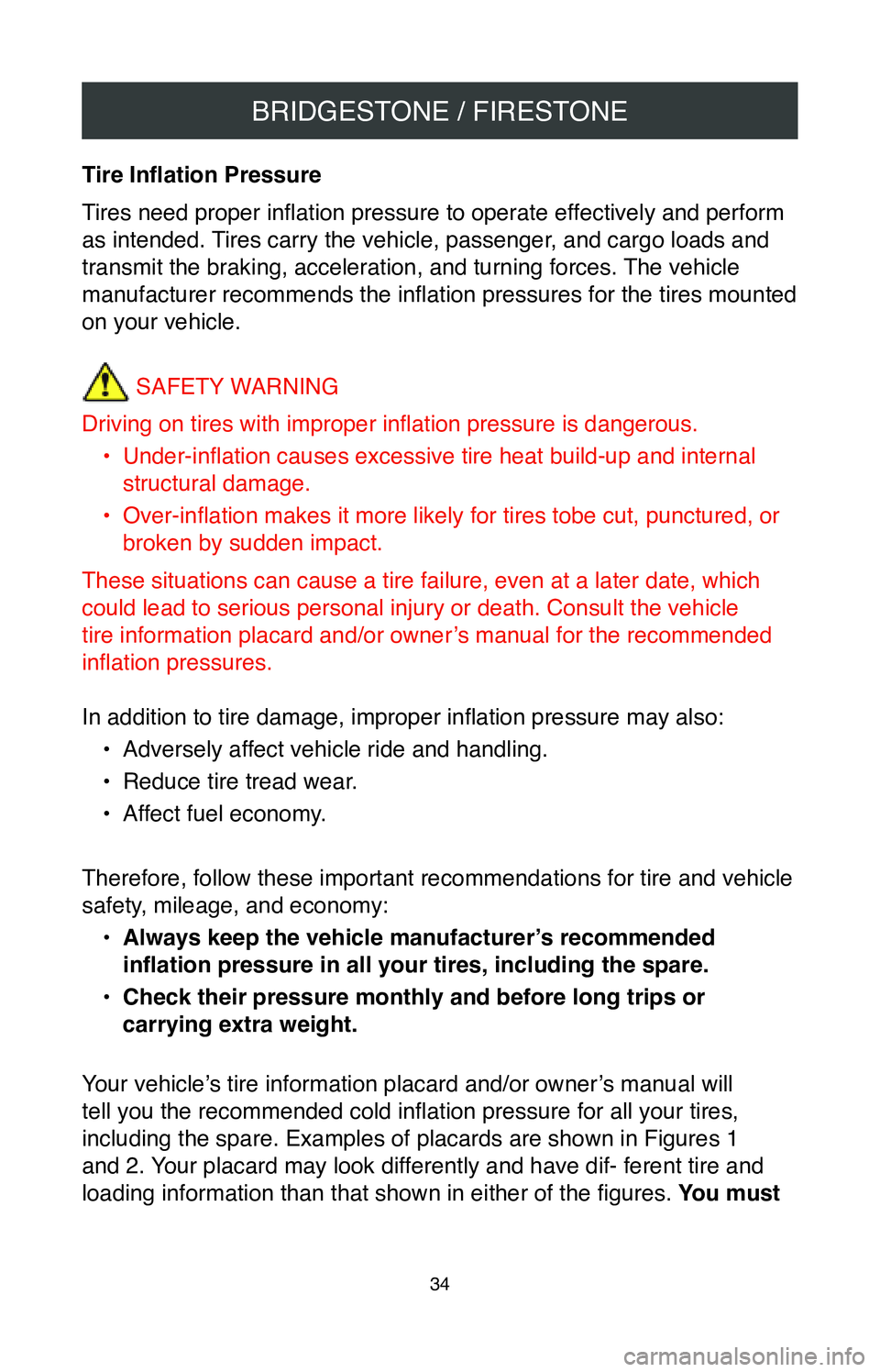
BRIDGESTONE / FIRESTONE
34
Tire Inflation Pressure
Tires need proper inflation pressure to operate effectively and perform
as intended. Tires carry the vehicle, passenger, and cargo loads and
transmit the braking, acceleration, and turning forces. The vehicle
manufacturer recommends the inflation pressures for the tires mounted
on your vehicle.SAFETY WARNING
Driving on tires with improper inflation pressure is dangerous. •
Under-inflation causes excessive tire heat build-up and internal
structural damage.
•
Over-inflation makes it more likely for tires tobe cut, punctured, or
broken by sudden impact.
These situations can cause a tire failure, even at a later date, which
could lead to serious personal injury or death. Consult the vehicle
tire information placard and/or owner’s manual for the recommended
inflation pressures.
In addition to tire damage, improper inflation pressure may also: •
Adversely affect vehicle ride and handling.
•
Reduce tire tread wear.
•
Affect fuel economy.
Therefore, follow these important recommendations for tire and vehicle
safety, mileage, and economy: •
Always keep the vehicle manufacturer’s recommended
inflation pressure in all your tires, including the spare.
•
Check their pressure monthly and before long trips or
carrying extra weight.
Your vehicle’s tire information placard and/or owner’s manual will
tell you the recommended cold inflation pressure for all your tires,
including the spare. Examples of placards are shown in Figures 1
and 2. Your placard may look differently and have dif- ferent tire and
loading information than that shown in either of the figures. You must
Page 37 of 260
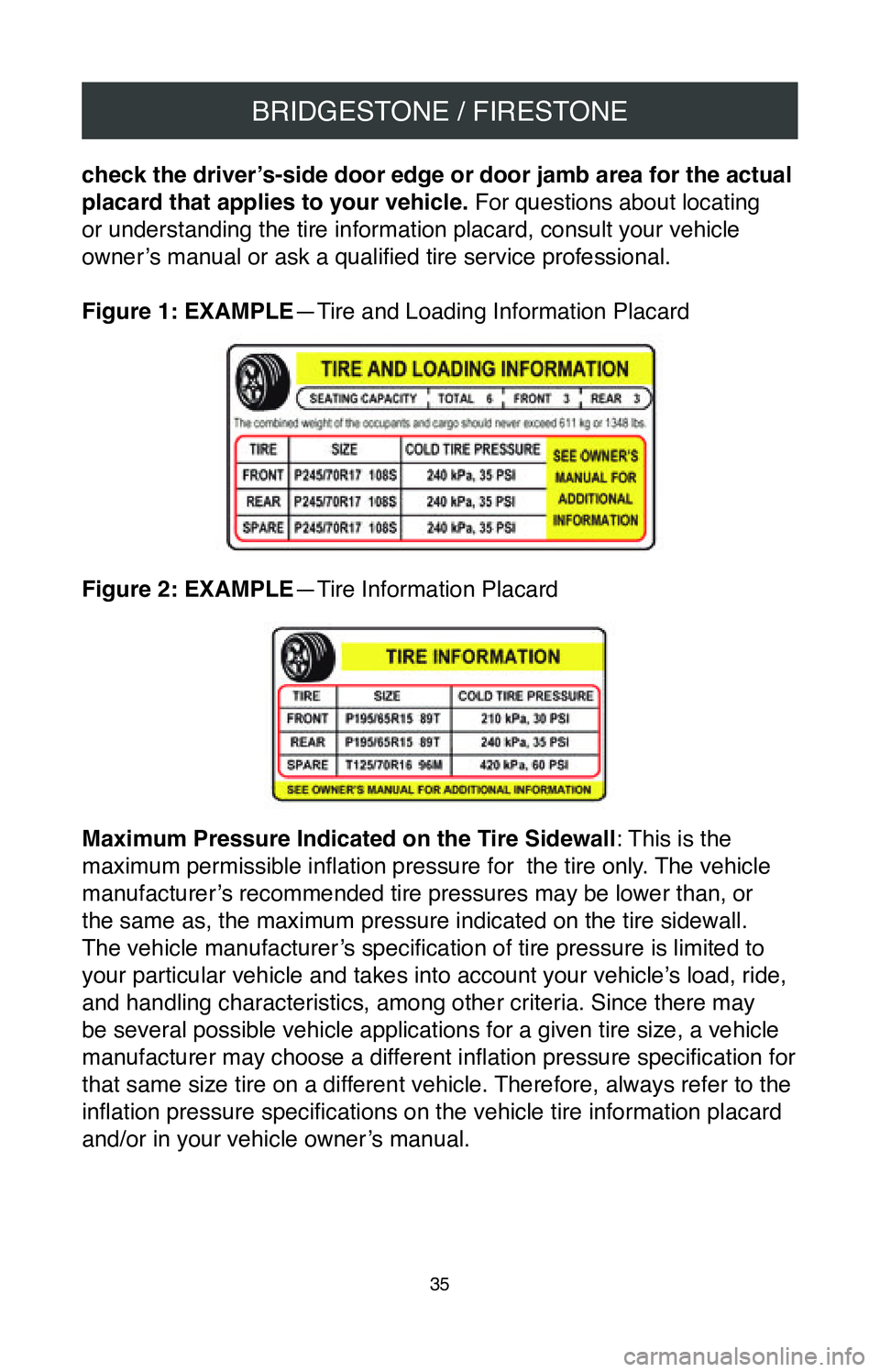
BRIDGESTONE / FIRESTONE
35
check the driver’s-side door edge or door jamb area for the actual
placard that applies to your vehicle. For questions about locating
or understanding the tire information placard, consult your vehicle
owner’s manual or ask a qualified tire service professional.
Figure 1: EXAMPLE —Tire and Loading Information Placard
Figure 2: EXAMPLE—Tire Information Placard
Maximum Pressure Indicated on the Tire Sidewall : This is the
maximum permissible inflation pressure for the tire only. The vehicle
manufacturer’s recommended tire pressures may be lower than, or
the same as, the maximum pressure indicated on the tire sidewall.
The vehicle manufacturer’s specification of tire pressure is limited to
your particular vehicle and takes into account your vehicle’s load, ride,
and handling characteristics, among other criteria. Since there may
be several possible vehicle applications for a given tire size, a vehicl\
e
manufacturer may choose a different inflation pressure specification for
that same size tire on a different vehicle. Therefore, always refer to the
inflation pressure specifications on the vehicle tire information placard
and/or in your vehicle owner’s manual.
Page 38 of 260
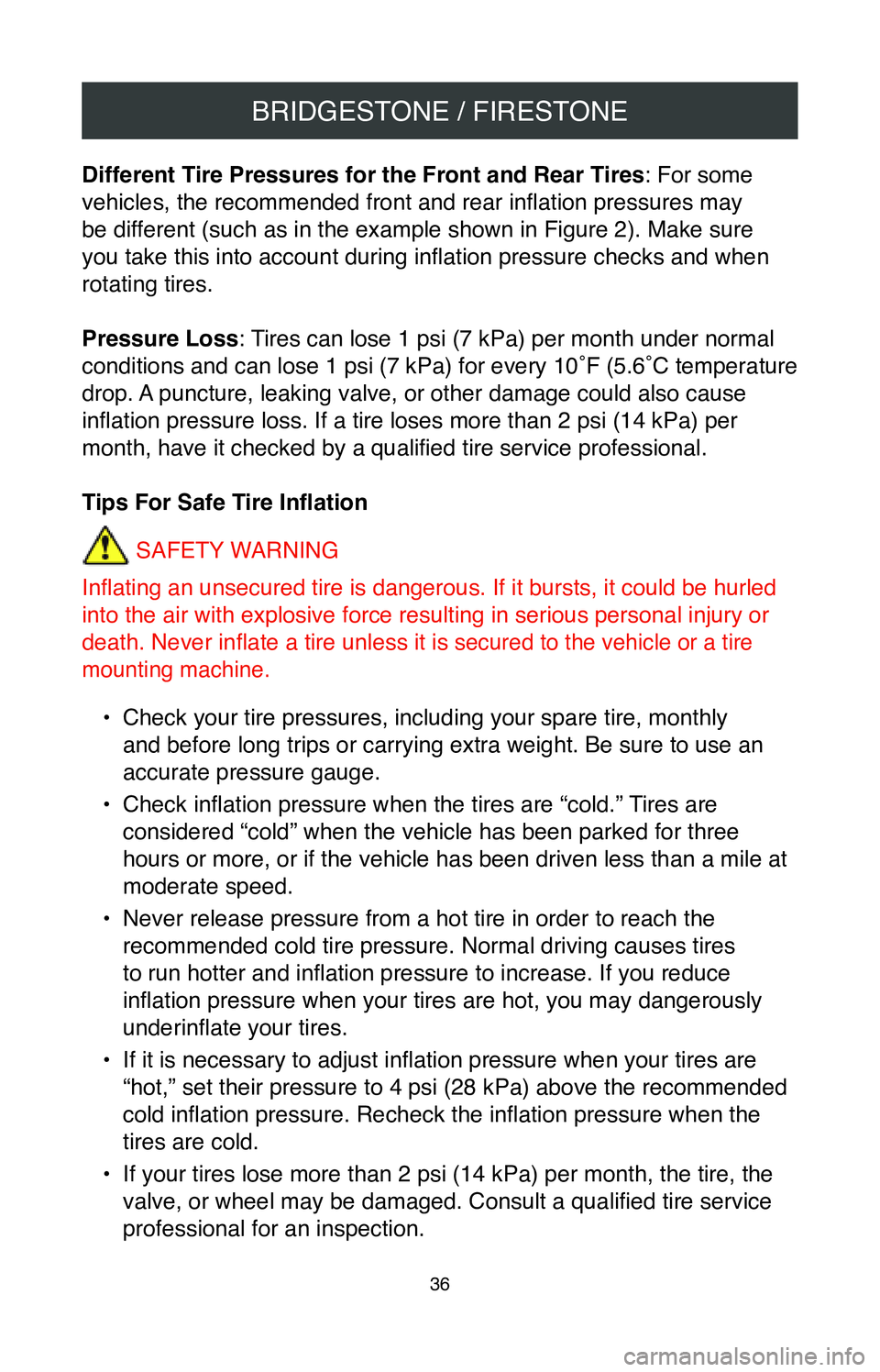
BRIDGESTONE / FIRESTONE
36
Different Tire Pressures for the Front and Rear Tires: For some
vehicles, the recommended front and rear inflation pressures may
be different (such as in the example shown in Figure 2). Make sure
you take this into account during inflation pressure checks and when
rotating tires.
Pressure Loss: Tires can lose 1 psi (7 kPa) per month under normal
conditions and can lose 1 psi (7 kPa) for every 10˚F (5.6˚C temperature
drop. A puncture, leaking valve, or other damage could also cause
inflation pressure loss. If a tire loses more than 2 psi (14 kPa) per
month, have it checked by a qualified tire service professional.
Tips For Safe Tire Inflation
SAFETY WARNING
Inflating an unsecured tire is dangerous. If it bursts, it could be hurled
into the air with explosive force resulting in serious personal injury or
death. Never inflate a tire unless it is
secured to the vehicle or a tire
mounting machine.
• Check your tire pressures, including your spare tire, monthly
and before long trips or carrying extra weight. Be sure to use an
accurate pressure gauge.
•
Check inflation pressure when the tires are “cold.” Tires are
considered “cold” when the vehicle has been parked for three
hours or more, or if the vehicle has been driven less than a mile at
moderate speed.
•
Never release pressure from a hot tire in order to reach the
recommended cold tire pressure. Normal driving causes tires
to run hotter and inflation pressure to increase. If you reduce
inflation pressure when your tires are hot, you may dangerously
underinflate your tires.
•
If it is necessary to adjust inflation pressure when your tires are
“hot,” set their pressure to 4 psi (28 kPa) above the recommended
cold inflation pressure. Recheck the inflation pressure when the
tires are cold.
•
If your tires lose more than 2 psi (14 kPa) per month, the tire, the
valve, or wheel may be damaged. Consult a qualified tire service
professional for an inspection.
Page 39 of 260
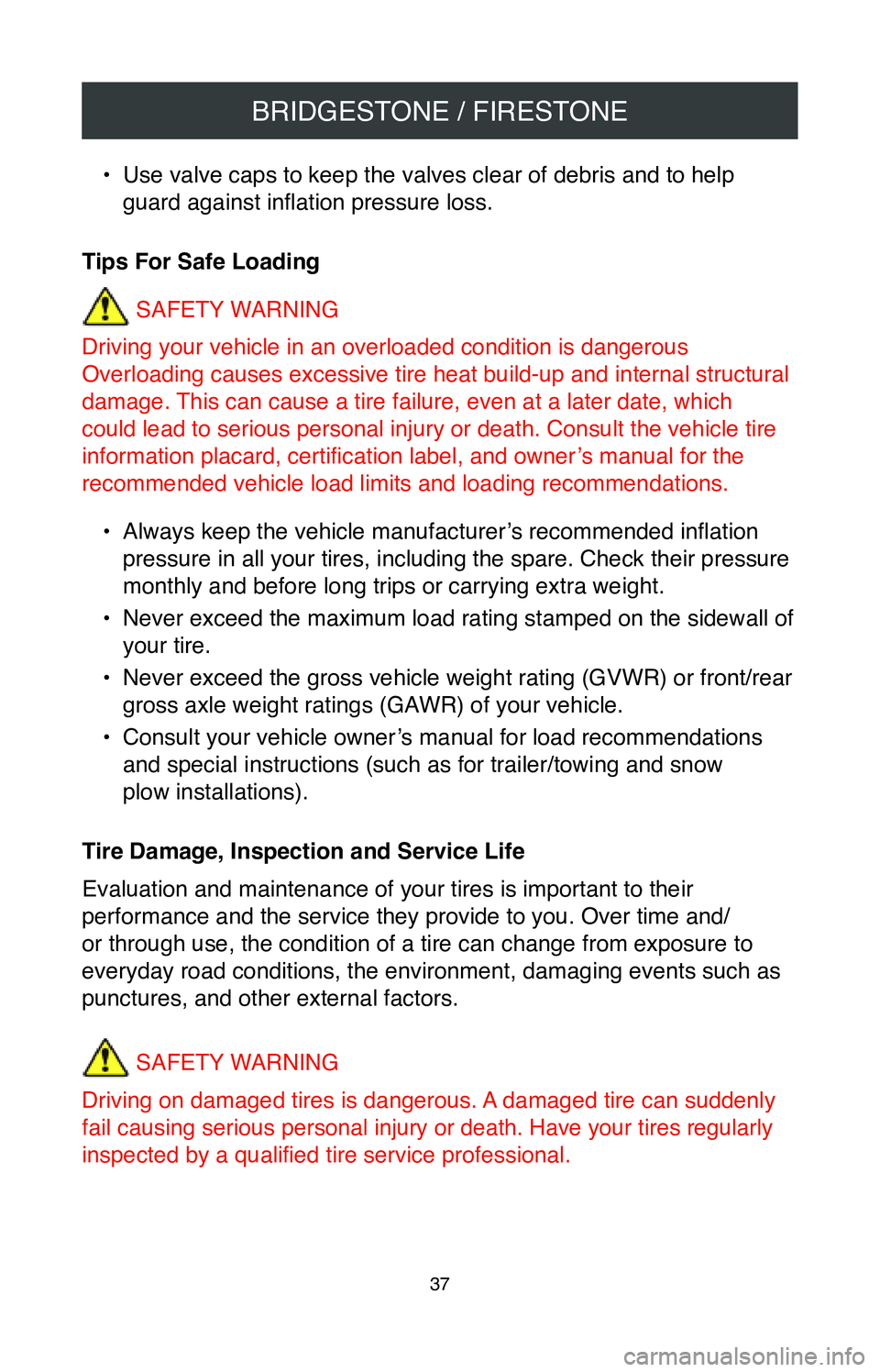
BRIDGESTONE / FIRESTONE
37
• Use valve caps to keep the valves clear of debris and to help
guard against inflation pressure loss.
Tips For Safe Loading SAFETY WARNING
Driving your vehicle in an overloaded condition is dangerous
Overloading causes excessive tire heat build-up and internal structural
damage. This can cause a tire failure, even at a later date, which
could lead to serious personal injury or death. Consult the vehicle tire
information placard, certification label, and owner’s manual for the
recommended vehicle load limits and loading recommendations.
•
Always keep the vehicle manufacturer’s recommended inflation
pressure in all your tires, including the spare. Check their pressure
monthly and before long trips or carrying extra weight.
•
Never exceed the maximum load rating stamped on the sidewall of
your tire.
•
Never exceed the gross vehicle weight rating (GVWR) or front/rear
gross axle weight ratings (GAWR) of your vehicle.
•
Consult your vehicle owner’s manual for load recommendations
and special instructions (such as for trailer/towing and snow
plow installations).
Tire Damage, Inspection and Service Life
Evaluation and maintenance of your tires is important to their
performance and the service they provide to you. Over time and/
or through use, the condition of a tire can change from exposure to
everyday road conditions, the environment, damaging events such as
punctures, and other external factors.
SAFETY WARNING
Driving on damaged tires is dangerous. A damaged tire can suddenly
fail causing serious
personal injury or death. Have your tires regularly
inspected by a qualified tire service professional.
Page 42 of 260
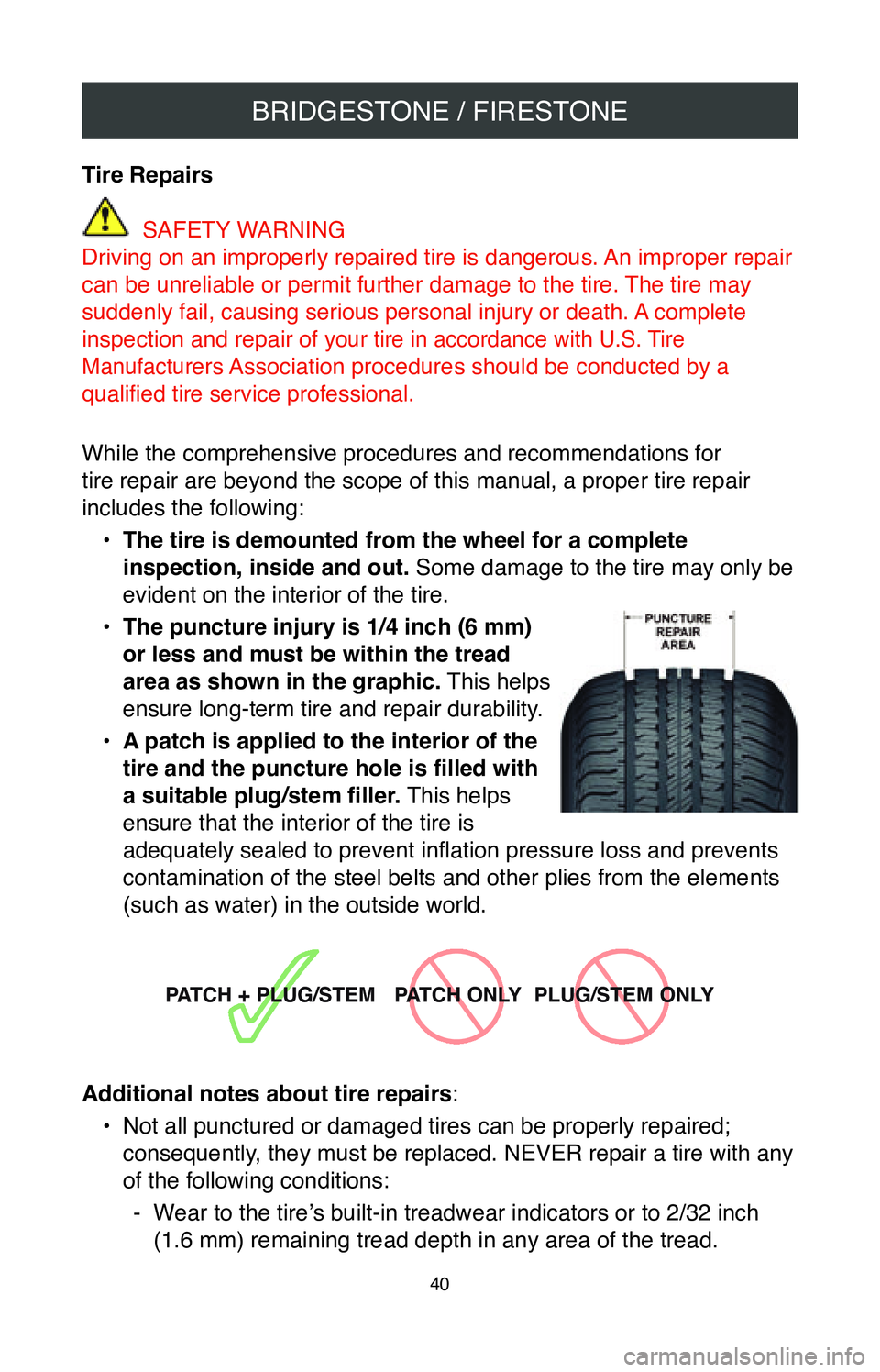
BRIDGESTONE / FIRESTONE
40
Tire Repairs
SAFETY WARNING
Driving on an improperly repaired tire is dangerous. An improper repair
can be unreliable or permit further damage to the tire. The tire may
suddenly fail, causing serious personal injury or death. A complete
inspection and repair of
your tire in accordance with U.S. Tire
Manufactur
ers Association procedures should be conducted by a
qualified tire service professional.
While the comprehensive procedures and recommendations for
tire repair are beyond the scope of this manual, a proper tire repair
includes the following:
•
The tire is demounted from the wheel for a complete
inspection, inside and out. Some damage to the tire may only be
evident on the interior of the tire.
•
The puncture injury is 1/4 inch (6 mm)
or less and must be within the tread
area as shown in the graphic. This helps
ensure long-term tire and repair durability.
•
A patch is applied to the interior of the
tire and the puncture hole is filled with
a suitable plug/stem filler. This helps
ensure that the interior of the tire is
adequately sealed to prevent inflation pressure loss and prevents
contamination of the steel belts and other plies from the elements
(such as water) in the outside world.
PATCH + PLUG/STEM PATCH ONLY PLUG/STEM ONLY
Additional notes about tire repairs :
•
Not all punctured or damaged tires can be properly repaired;
consequently, they must be replaced. NEVER repair a tire with any
of the following conditions:
- Wear to the tire’s built-in treadwear indicators or to 2/32 inch (1.6 mm) remaining tread depth in any area of the tread.
Page 43 of 260
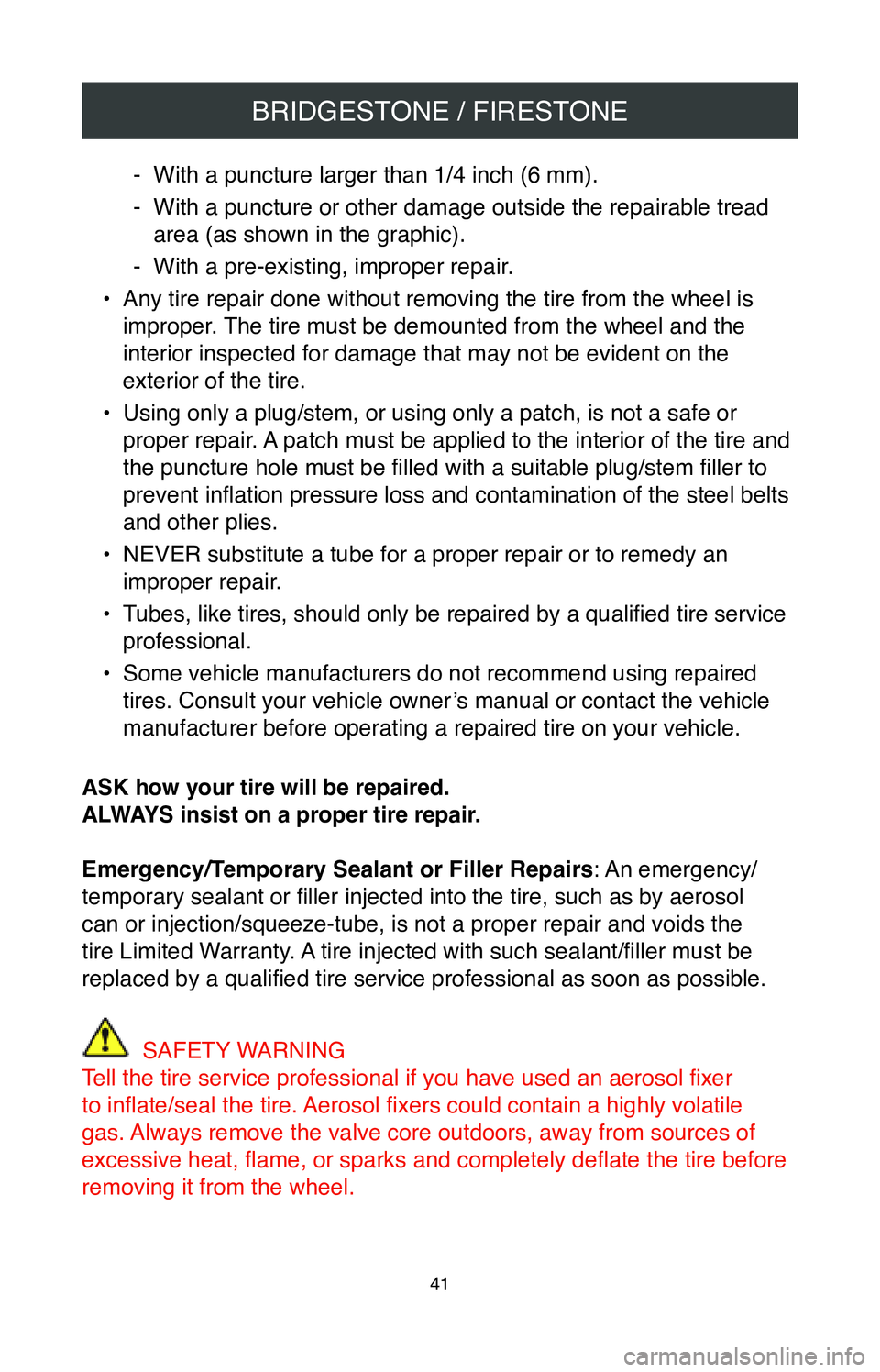
BRIDGESTONE / FIRESTONE
41
- With a puncture larger than 1/4 inch (6 mm).
-With a puncture or other damage outside the repairable tread
area (as shown in the graphic).
- With a pre-existing, improper repair.
•
Any tire repair done without removing the tire from the wheel is
improper. The tire must be demounted from the wheel and the
interior inspected for damage that may not be evident on the
exterior of the tire.
•
Using only a plug/stem, or using only a patch, is not a safe or
proper repair. A patch must be applied to the interior of the tire and
the puncture hole must be filled with a suitable plug/stem filler to
prevent inflation pressure loss and contamination of the steel belts
and other plies.
•
NEVER substitute a tube for a proper repair or to remedy an
improper repair.
•
Tubes, like tires, should only be repaired by a qualified tire service
professional.
•
Some vehicle manufacturers do not recommend using repaired
tires. Consult your vehicle owner’s manual or contact the vehicle
manufacturer before operating a repaired tire on your vehicle.
ASK how your tire will be repaired.
ALWAYS insist on a proper tire repair.
Emergency/Temporary Sealant or Filler Repairs: An emergency/
temporary sealant or filler injected into the tire, such as by aerosol
can or injection/squeeze-tube, is not a proper repair and voids the
tire Limited Warranty. A tire injected with such sealant/filler must be
replaced by a qualified tire service professional as soon as possible.
SAFETY WARNING
Tell the tire service professional if you have used an aerosol fixer
to inflate/seal the tire. Aerosol fixers could contain a highly volatile
gas. Always remove the valve core outdoors, away from sources of
excessive heat, flame, or sparks and completely deflate the tire before
removing it from the wheel.
Page 44 of 260
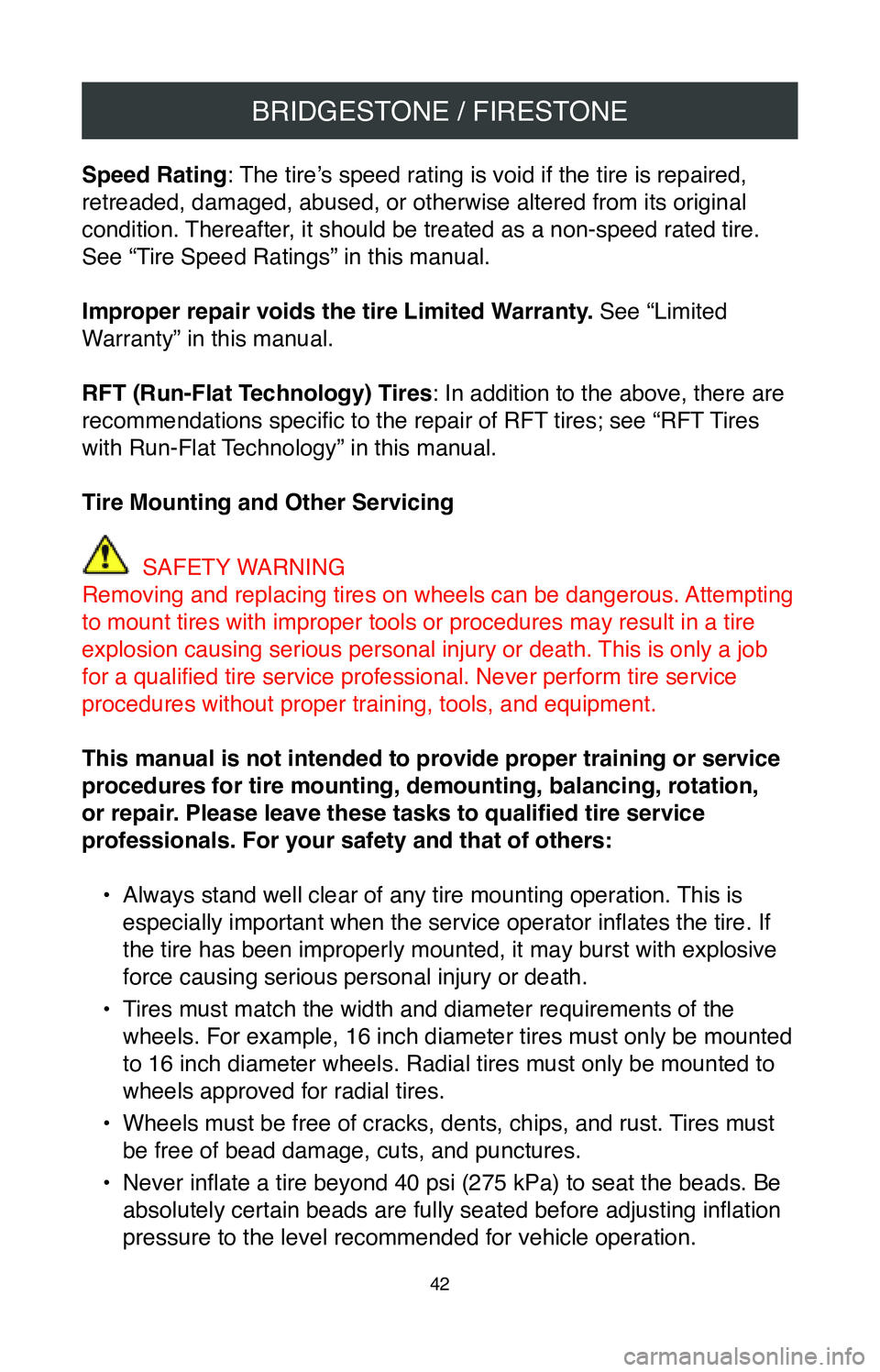
BRIDGESTONE / FIRESTONE
42
Speed Rating: The tire’s speed rating is void if the tire is repaired,
retreaded, damaged, abused, or otherwise altered from its original
condition. Thereafter, it should be treated as a non-speed rated tire.
See “Tire Speed Ratings” in this manual.
Improper repair voids the tire Limited Warranty. See “Limited
Warranty” in this manual.
RFT (Run-Flat Technology) Tires: In addition to the above, there are
recommendations specific to the repair of RFT tires; see “RFT Tires
with Run-Flat Technology” in this manual.
Tire Mounting and Other Servicing
SAFETY WARNING
Removing and replacing tires on wheels can be dangerous. Attempting
to mount tires with improper tools or procedures may result in a tire
explosion causing serious personal injury or death. This is only a job
for a qualified tire service professional. Never perform tire service
procedures without proper training, tools, and equipment.
This manual is not intended to provide proper training or service
procedures for tire mounting, demounting, balancing, rotation,
or repair. Please leave these tasks to qualified tire service
professionals. For your safety and that of others:
•
Always stand well clear of any tire mounting operation. This is
especially important when the service operator inflates the tire. If
the tire has been improperly mounted, it may burst with explosive
force causing serious personal injury or death.
•
Tires must match the width and diameter requirements of the
wheels. For example, 16 inch diameter tires must only be mounted
to 16 inch diameter wheels. Radial tires must only be mounted to
wheels approved for radial tires.
•
Wheels must be free of cracks, dents, chips, and rust. Tires must
be free of bead damage, cuts, and punctures.
•
Never inflate a tire beyond 40 psi (275 kPa) to seat the beads. Be
absolutely certain beads are fully seated before adjusting inflation
pressure to the level recommended for vehicle operation.
Page 45 of 260
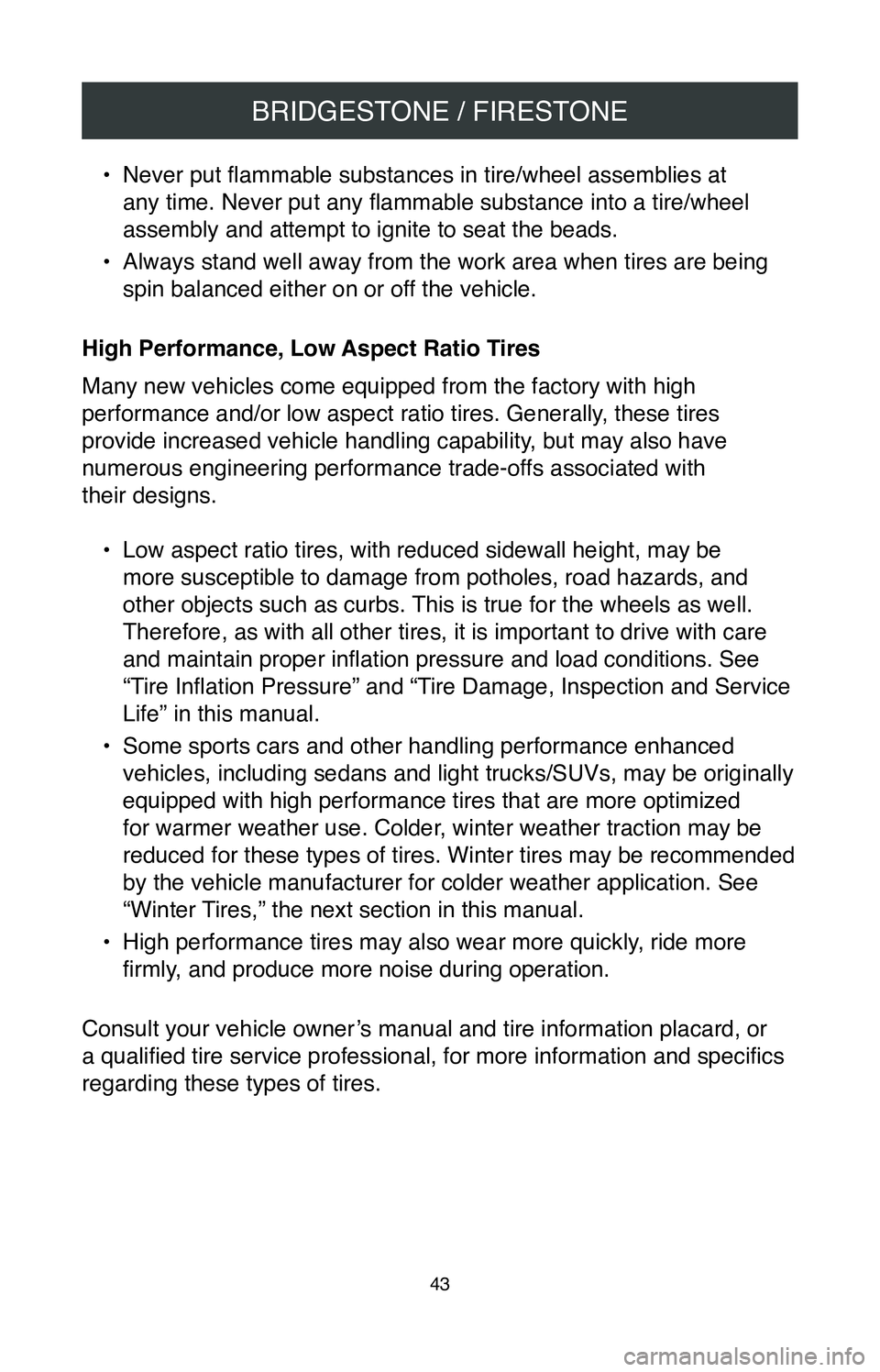
BRIDGESTONE / FIRESTONE
43
• Never put flammable substances in tire/wheel assemblies at
any time. Never put any flammable substance into a tire/wheel
assembly and attempt to ignite to seat the beads.
•
Always stand well away from the work area when tires are being
spin balanced either on or off the vehicle.
High Performance, Low Aspect Ratio Tires
Many new vehicles come equipped from the factory with high
performance and/or low aspect ratio tires. Generally, these tires
provide increased vehicle handling capability, but may also have
numerous engineering performance trade-offs associated with
their designs. •
Low aspect ratio tires, with reduced sidewall height, may be
more susceptible to damage from potholes, road hazards, and
other objects such as curbs. This is true for the wheels as well.
Therefore, as with all other tires, it is important to drive with care
and maintain proper inflation pressure and load conditions. See
“Tire Inflation Pressure” and “Tire Damage, Inspection and Service
Life” in this manual.
•
Some sports cars and other handling performance enhanced
vehicles, including sedans and light trucks/SUVs, may be originally
equipped with high performance tires that are more optimized
for warmer weather use. Colder, winter weather traction may be
reduced for these types of tires. Winter tires may be recommended
by the vehicle manufacturer for colder weather application. See
“Winter Tires,” the next section in this manual.
•
High performance tires may also wear more quickly, ride more
firmly, and produce more noise during operation.
Consult your vehicle owner’s manual and tire information placard, or
a qualified tire service professional, for more information and specifics
regarding these types of tires.
Page 48 of 260
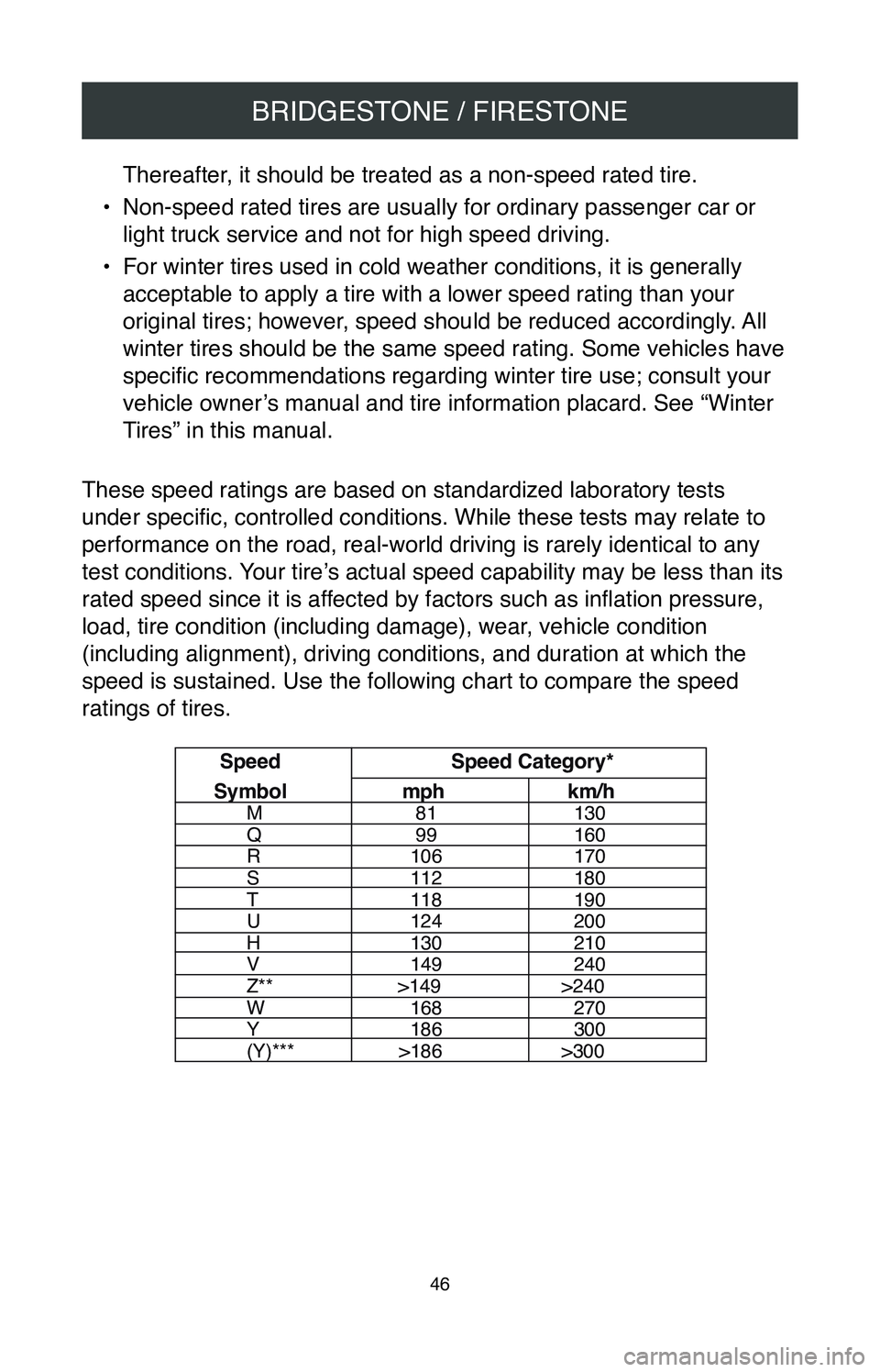
BRIDGESTONE / FIRESTONE
46
Thereafter, it should be treated as a non-speed rated tire.
•
Non-speed rated tires are usually for ordinary passenger car or
light truck service and not for high speed driving.
•
For winter tires used in cold weather conditions, it is generally
acceptable to apply a tire with a lower speed rating than your
original tires; however, speed should be reduced accordingly. All
winter tires should be the same speed rating. Some vehicles have
specific recommendations regarding winter tire use; consult your
vehicle owner’s manual and tire information placard. See “Winter
Tires” in this manual.
These speed ratings are based on standardized laboratory tests
under specific, controlled conditions. While these tests may relate to
performance on the road, real-world driving is rarely identical to any
test conditions. Your tire’s actual speed capability may be less than its
rated speed since it is affected by factors such as inflation pressure,
load, tire condition (including damage), wear, vehicle condition
(including alignment), driving conditions, and duration at which the
speed is sustained. Use the following chart to compare the speed
ratings of tires.
Speed Speed Category*
Symbol mph km/h
M81130
Q 99160
R 106170
S 112180
T 118190
U 124200
H 130210
V 149240
Z** >149 >240
W 168270
Y 186300
(Y)*** >186 >300